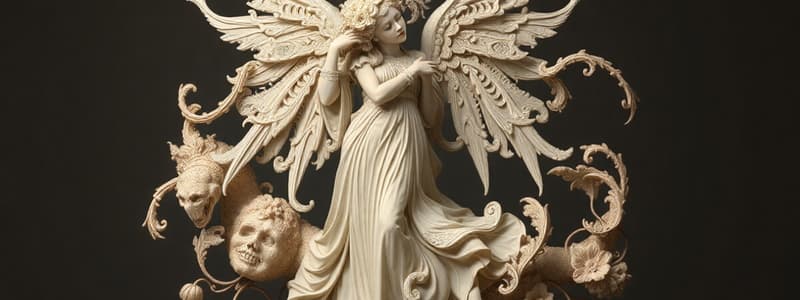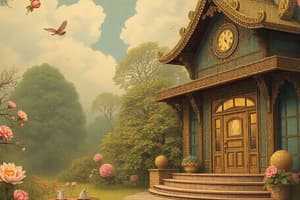Podcast
Questions and Answers
Which of the following best describes the primary function of performing arts?
Which of the following best describes the primary function of performing arts?
- To present art forms live to an audience. (correct)
- To document cultural traditions through written texts.
- To preserve historical artifacts for future generations.
- To create static visual displays for contemplation.
How do museums and galleries contribute to art appreciation?
How do museums and galleries contribute to art appreciation?
- By limiting access to art to a select scholarly audience.
- By dictating the monetary value of artworks.
- By providing spaces for education, research, and public engagement with art. (correct)
- By focusing solely on preserving art from a specific historical period.
Which of the following art forms is LEAST likely to rely on a live audience for its primary presentation?
Which of the following art forms is LEAST likely to rely on a live audience for its primary presentation?
- Theatre
- Film (correct)
- Dance
- Performance art
How can art function as social commentary?
How can art function as social commentary?
Which of the following is an example of interdisciplinary art?
Which of the following is an example of interdisciplinary art?
If a play aims to critique political corruption, which role of art is it primarily fulfilling?
If a play aims to critique political corruption, which role of art is it primarily fulfilling?
Why is art education considered essential?
Why is art education considered essential?
Which of the following scenarios best illustrates how art preserves and transmits cultural traditions?
Which of the following scenarios best illustrates how art preserves and transmits cultural traditions?
How does art contribute to an individual's mental well-being?
How does art contribute to an individual's mental well-being?
Which of these is a typical characteristic of prose?
Which of these is a typical characteristic of prose?
Which of the following activities best demonstrates the fusion of aesthetic considerations with practical requirements?
Which of the following activities best demonstrates the fusion of aesthetic considerations with practical requirements?
A visual artist is commissioned to create a piece that embodies both functionality and artistic expression. Which medium would be the MOST suitable?
A visual artist is commissioned to create a piece that embodies both functionality and artistic expression. Which medium would be the MOST suitable?
An artist aims to create a series of works that can be easily reproduced and distributed. Which visual art form is BEST suited?
An artist aims to create a series of works that can be easily reproduced and distributed. Which visual art form is BEST suited?
Which scenario exemplifies the use of literary arts to evoke emotions and convey ideas through the aesthetic and rhythmic qualities of language?
Which scenario exemplifies the use of literary arts to evoke emotions and convey ideas through the aesthetic and rhythmic qualities of language?
An artist wants to create three-dimensional artworks using durable materials that can withstand outdoor conditions. Which set of materials are MOST appropriate?
An artist wants to create three-dimensional artworks using durable materials that can withstand outdoor conditions. Which set of materials are MOST appropriate?
Which choice describes an artist using creative imagination to express emotional power, rather than technical skill or conceptual ideas?
Which choice describes an artist using creative imagination to express emotional power, rather than technical skill or conceptual ideas?
Which method relies LEAST on the physical manipulation of materials and MOST on capturing and arranging light?
Which method relies LEAST on the physical manipulation of materials and MOST on capturing and arranging light?
An artist is commissioned to produce artwork for a public space that is robust, weather-resistant, and visually engaging, while also serving a practical function. Which artistic endeavor would be MOST appropriate given these requirements?
An artist is commissioned to produce artwork for a public space that is robust, weather-resistant, and visually engaging, while also serving a practical function. Which artistic endeavor would be MOST appropriate given these requirements?
Flashcards
Arts Definition
Arts Definition
Creative activities expressing skill, beauty, or ideas, resulting in artifacts or performances.
Visual Arts
Visual Arts
Art forms primarily visual, like painting, sculpture, and photography.
Painting
Painting
Applying pigments to a surface to create an image or design.
Sculpture
Sculpture
Signup and view all the flashcards
Drawing
Drawing
Signup and view all the flashcards
Printmaking
Printmaking
Signup and view all the flashcards
Ceramics
Ceramics
Signup and view all the flashcards
Literary Arts
Literary Arts
Signup and view all the flashcards
Prose
Prose
Signup and view all the flashcards
Novels and Short Stories
Novels and Short Stories
Signup and view all the flashcards
Essays
Essays
Signup and view all the flashcards
Drama
Drama
Signup and view all the flashcards
Performing Arts
Performing Arts
Signup and view all the flashcards
Theatre
Theatre
Signup and view all the flashcards
Music
Music
Signup and view all the flashcards
Dance
Dance
Signup and view all the flashcards
Interdisciplinary Art Forms
Interdisciplinary Art Forms
Signup and view all the flashcards
Art Appreciation
Art Appreciation
Signup and view all the flashcards
Study Notes
- Arts encompass human activities using creative imagination to express technical skill, beauty, emotional power, or ideas.
- These activities typically produce artifacts or performances appreciated for aesthetic or emotional qualities.
- Art is classified into visual, performing, and literary arts.
Visual Arts
- Visual arts create primarily visual works.
- They include painting, sculpture, drawing, printmaking, ceramics, photography, video, filmmaking, architecture, design, and crafts.
- Painting applies pigments to surfaces like canvas, paper, or walls to create images, representations, or designs.
- Common painting mediums are oil, watercolor, acrylic, and tempera.
- Sculpture is a three-dimensional art form shaping or combining hard/plastic materials.
- Stone, metal, wood, clay, and glass are common sculpture materials.
- Drawing involves making marks on paper using graphite, charcoal, ink, and pastels.
- Printmaking creates multiple original impressions from a prepared surface.
- Etching, engraving, lithography, and screen printing are printmaking techniques.
- Ceramics involves creating objects from clay hardened by firing.
- Pottery, stoneware, porcelain, and terracotta are common ceramic forms.
- Photography captures images using a camera and light.
- It requires technical skill and artistic vision to create compelling visual content.
- Video art and filmmaking create moving images for artistic expression.
- Experimental films, documentaries, and narrative films are included.
- Architecture designs buildings and structures, blending aesthetics and function.
- Design includes graphic, industrial, fashion, and interior design.
- Crafts create handmade, functional, and decorative objects.
- Textiles, jewelry, woodworking, and glassblowing are craft examples.
Literary Arts
- Literary arts create written works valued for aesthetic and intellectual qualities.
- They include poetry, prose (novels, short stories, essays), and drama.
- Poetry uses language's aesthetic and rhythmic qualities to evoke emotions or convey ideas.
- Metaphor, simile, and alliteration are poetry techniques.
- Prose includes novels, short stories, essays, and non-metrical written expression.
- Novels and short stories are fiction narrating events and depicting characters/themes.
- Essays explore topics from personal or analytical perspectives.
- Drama is literature intended for performance, using dialogue/action to tell stories.
Performing Arts
- Performing arts are presented live to an audience.
- They include theatre, music, dance, and film.
- Theatre performs dramatic works by actors, combining literature, visuals, and music.
- Music uses organized sound and silence to express emotions or ideas.
- It covers vocal, instrumental, and electronic forms.
- Dance expresses movement through the human body.
- It can be performed with or without music, conveying emotions or stories.
- Interdisciplinary art combines elements from different disciplines.
- Performance art involves live events or actions conceived and executed by artists.
- Digital art uses digital technology as part of the creative process.
- Installation art creates immersive, site-specific environments.
Art and Culture
- Art shapes and reflects culture, expressing values, beliefs, and identities.
- Art serves as social commentary, addressing political, economic, and social issues.
- It can challenge norms, provoke dialogue, and drive change.
- Art preserves and transmits cultural traditions across generations.
- Traditional art reflects unique customs, rituals, and beliefs.
- Art appreciation values the aesthetic, cultural, and historical significance of artworks.
- It requires openness, sensitivity, and engagement with different expressions.
- Museums, galleries, and institutions preserve and exhibit art.
- They offer education, research, and public engagement.
Art and Society
- Art influences and shapes society, inspiring, provoking, and challenging viewers.
- It encourages critical thinking about oneself and the world.
- Art serves as therapy, helping individuals express emotions and cope with stress.
- Art education develops creativity, critical thinking, and cultural awareness.
- It fosters lifelong appreciation and contributes to an engaged society.
- Art markets support artists, galleries, and related industries.
- They provide platforms for buying/selling artworks and influence artist recognition.
- Art promotes social justice and equality.
- It raises awareness, challenges stereotypes, and advocates for change.
Studying That Suits You
Use AI to generate personalized quizzes and flashcards to suit your learning preferences.




